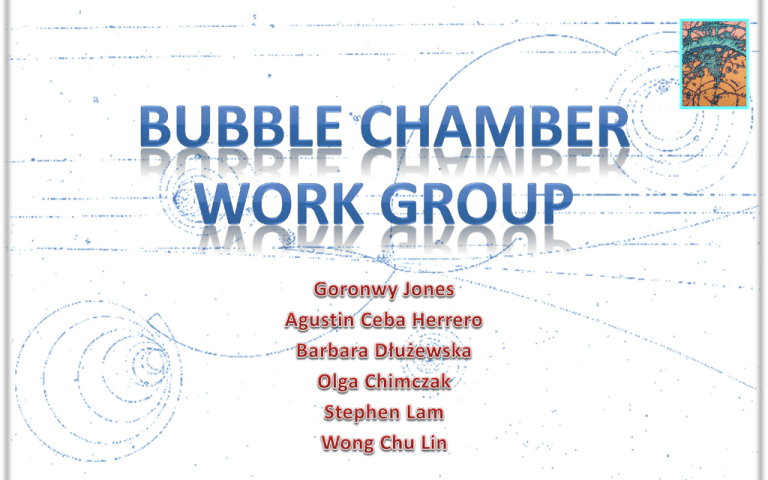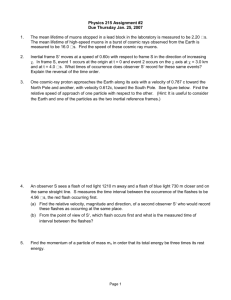Bubble Chamber Work Group Presentation
advertisement

• • • • • Targets of our work group Simple lessons with BC photographs History of BC Overview of 50-minutes lesson FAQs • To create simple lesson with BC photographs • To update webpage on history of BC • To create 50 minutes modular lesson for teaching BC concepts • To create webpage of frequently-asked questions (FAQs) • You can make your own cloud chamber and see tracks of particles produced by cosmic rays • Click here for instructions • When a charged particle goes through a superheated liquid, it ionises atoms along its path and makes the liquid boil, creating a trail of bubbles • Click here for a simulation of bubble formation A plane in the sky causes water vapour in the air to condense Charged particle in BC causes superheated liquid to boil • The different coloured tracks are produced by different charged particles Kp B – Bright Green kaon K– Red electron e– Blue proton p • Why are tracks curve? Click here for discussion A e • A particle of charge q travelling through a magnetic field B with a velocity v experiences a force, given by F q(v B ) • We use the formula for the Lorentz force to calculate the value and direction of the force exerted on charged particles by the magnetic field • The thumb points in the direction of the force F • First finger points in the direction of the magnetic field B • Second finger points in the direction of motion of the positive charge v • In principle, the momentum of a charged particle is obtained using the formula p B q r v B + - F F v • Spiralling tracks are common in BC photographs, caused by e- or e+ • An e- loses energy at a considerable rate as it travels through BC liquid • All other charged particles, unless they collide with a nucleus, slow down very gradually – get more curved – as they lose energy by ionisation • e- are able to lose energy more quickly by another process in which all accelerated charges radiate • Click here for more information Dark tracks belong to a slow particle Spiralling tracks are e- because of their very small mass Particles with large momenta are less curved Particles with small momenta are more curved • All physical laws must be fulfilled in every BC event – Momentum conservation – Charge conservation – Energy conservation – Behaviour of moving charged particles in magnetic field – Other physics laws • The primary (orange) beam has –ve charge while one of the two secondary beams has –ve charge (green) and the other +ve charge (bright green) • We also know that the two outgoing tracks have low momentum because they curve significantly in B-field • What is the direction of the momentum of the primary beam? • Estimate the momenta of the secondary tracks • What is the total momentum after interaction? • Clearly the total momentum of the outgoing charged particles does not equal to the momentum of the beam particle • Draw an arrow to show the “missing” momentum • Click here for more info • In all BC photographs, the charge of the particle can be only +e or -e • Sign of particles can be determined by the direction of the track’s curvature • Click here to find this • The primary beam is K• What are the charges of secondary particles? [Hint: the red spiral is produced by an electron] • Green is negative and bright green is positive • If this event do not involve other particle, total charge before interaction (-e) is not equal to the total charge after it (0) • But the collision involves a proton (+e), so the total charge is conserved • Here is another picture that could be used for a similar exercise • Improve and publish a webpage on history of BC – Birth and evolution of BC and its main discoveries – Important photographs – 2 articles on history of BC and personal experience • PowerPoint on history of BC Cloud chamber Anderson (1932), positron (e+) Nuclear Emulsion Powell (1947), pion p+ • It’s faster to reactivate than cloub chambers • The expansion of BC can coincide with the accelerator cycle • BC were very small initially; only a few cubic centimetre of liquid • Big European Bubble Chamber (BEBC) in 70’s has a diameter of 3.7 m • 1956. Discovery of S0 in a propane BC • 1964. Discovery of - which gives acceptance of GellMann theory of ordering all subatomic particle “eightfold way” • 1973. Neutral current discovered at CERN’s 25-ton Gargamelle • 1975. Discovery of “charmed” baryon in 7-foot Brookhaven • Research on earlier particle detectors – cloud chamber & nuclear emulsions • Design a PowerPoint presentation using the contents of the webpage • Short biographies of the people who developed the BC • Lesson 1 – “Introduction to BC and Basic Feature of the Interactions” – Photographs, Worksheet 1 • Lesson 2 – “Identifying the Particles and Conservation of momentum & Charge” • Lesson 3 – “Particle Interactions – Collisions & Decays” • Lesson 4 – “Principle of determination of momentum” • Lesson 5 – “Principle of determination of energy” • Lesson 6 – “More complex BC photographs” What does LHC stand for? • Large Hadron Collider. Click here for further detail. What are antiparticles? • To every particle that has a non-zero value of some quantity such as electric charge, it is possible to create another particle with the opposite value – this is the antiparticle of the original one. For an example, click here. • Profile of Jonni Fulcher • An example of a collision • Jonni Fulcher Stunts You may need to install the xvid codec - you can download it from here







